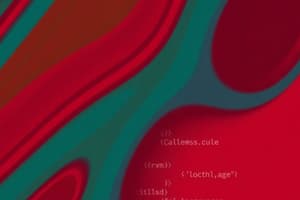Podcast
Questions and Answers
What is the primary function of an assembler?
What is the primary function of an assembler?
- To convert assembly language to machine language (correct)
- To compile programs into object code
- To process source code line by line
- To execute high-level programming code
Which best describes the role of a linker in programming?
Which best describes the role of a linker in programming?
- It translates assembly language to a higher-level language
- It combines multiple object files into a single executable (correct)
- It compiles and executes code simultaneously
- It converts high-level language directly into machine code
What is the purpose of directives in assembly language?
What is the purpose of directives in assembly language?
- To provide instructions to the assembler (correct)
- To execute instructions directly
- To define user variables
- To compile high-level code
In assembly language, what does the 'DB' directive represent?
In assembly language, what does the 'DB' directive represent?
What does the 'END' directive signify in a program?
What does the 'END' directive signify in a program?
Which statement correctly defines a 'variable' in programming?
Which statement correctly defines a 'variable' in programming?
In assembly programming, what does the term 'label' refer to?
In assembly programming, what does the term 'label' refer to?
What memory model does the term 'Large' refer to in assembly language?
What memory model does the term 'Large' refer to in assembly language?
What does the MUL instruction do?
What does the MUL instruction do?
Which command is used to remove a specific subdirectory in DOS?
Which command is used to remove a specific subdirectory in DOS?
How does the SHL instruction manipulate bits?
How does the SHL instruction manipulate bits?
What is the purpose of the INT 21H instruction?
What is the purpose of the INT 21H instruction?
What does the ROL instruction do?
What does the ROL instruction do?
Which command allows creating a program in mnemonic code?
Which command allows creating a program in mnemonic code?
What does the LEA instruction do?
What does the LEA instruction do?
Which numeric constant prefix is used for hexadecimal numbers?
Which numeric constant prefix is used for hexadecimal numbers?
Flashcards are hidden until you start studying
Study Notes
Assembly Language
- Assembly language is a low-level programming language that directly communicates with computer hardware.
Compiler
- Compiler is a program that converts high/mid-level language code into executable machine code.
Assembler
- Assembler is a program that converts assembly language code into machine language instructions.
Interpreter
- Interpreter processes and translates high/mid-level language code statement by statement and executes each statement individually.
Linker
- Linker combines object files, libraries, and other components to generate an executable program.
Comments
- Comments improve the readability and clarity of a program.
Directives
- Directives are statements that provide information to the assembler.
Operators
- Operators are used during assembly to influence the value of an operand.
Pre-defined Symbols
- Pre-defined symbols provide information to your program during execution.
Variables
- Variables are user-defined names that represent data.
Name
- A name represents the address of a data item.
Label
- A label represents the address of an instruction or procedure.
Title
- The title of the source listing is limited to 60 characters.
Dosseg
- Dosseg directive tells the assembler to adopt the DOS segment sequence: stack, data, and code.
Model
- The Model directive specifies and initializes the memory model before defining any segment.
Small Model
- Small model uses one code segment and one data segment.
Large Model
- Large model uses one data segment of 64k and multiple code segments.
Compact Model
- Compact model uses one code segment of 64k and multiple data segments.
Stack
- Stack defines the size of the stack, with a default size of 1,024 bytes.
DATA
- The DATA directive marks the beginning of the data segment.
Code
- The CODE directive marks the beginning of the code segment, which contains instructions.
END
- The END directive is placed at the end of the source program.
DB
- DB is used for defining 8-bit integers.
FWORD
- FWORD is used for defining 48-bit integers.
String
- Strings are used for descriptive data such as names or messages.
Numeric Constant
- Numeric constants can be defined using radix specifiers like 'd' for decimal, 'b' for binary, and 'h' for hexadecimal.
MUL
- The MUL instruction multiplies the value in a register with the value in the AX register.
MOV
- The MOV instruction copies data between registers or from an immediate value to a register.
Carry Flag
- The Carry flag stores information about whether an unsigned operation resulted in a value larger than the destination location could hold.
Data Register
- There are four 32-bit data registers used for arithmetic, logical, and other operations.
Shift-Left-Instructions
- Shift-left instructions shift the bits of an operand to the left, filling the lowest bit with a 0.
SAL
- SAL is identical to the SHL (shift left) instruction.
REN
- The REN command in DOS allows you to rename files.
MD
- The MD (Make Directory) command creates a new subdirectory.
RD
- The RD (Remove Directory) command removes a subdirectory.
DIR
- The DIR (Directory) command lists the contents of a directory.
A
- The A command in DEBUG allows you to create a program in mnemonic or symbolic code.
U
- The U (Unassemble) command in DEBUG displays the assembly code of the program.
D
- The D (Dump) command in DEBUG displays the contents of memory in hexadecimal and ASCII format.
R
- The R (Register) command in DEBUG displays the values of all registers.
TLINK
- TLINK (Turbo Linker) is a linker that combines object files, libraries, etc. into an executable program.
MOV AH, 01H
- This instruction requests character input.
INT 21H
- This instruction invokes an interrupt service.
MOV DL, 24H
- This instruction sets the column size.
MOV AH, 08h
- This instruction requests character input without displaying the entered characters on the screen.
0A
- Represents the Line Feed character.
0D
- Represents the Carriage Return character.
ROL
- The ROL (Rotate Left) instruction shifts each bit to the left, with the highest bit copied into the Carry flag and then into the lowest bit.
LEA
- The LEA (Load Effective Address) instruction places the address specified by its first operand into the register specified by its second operand.
Studying That Suits You
Use AI to generate personalized quizzes and flashcards to suit your learning preferences.




